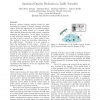Free Online Productivity Tools
i2Speak
i2Symbol
i2OCR
iTex2Img
iWeb2Print
iWeb2Shot
i2Type
iPdf2Split
iPdf2Merge
i2Bopomofo
i2Arabic
i2Style
i2Image
i2PDF
iLatex2Rtf
Sci2ools
80
Voted
SDM
2008
SIAM
2008
SIAM
Statistical Density Prediction in Traffic Networks
Recently, modern tracking methods started to allow capturing the position of massive numbers of moving objects. Given this information, it is possible to analyze and predict the traffic density in a network which offers valuable information for traffic control, congestion prediction and prevention. In this paper, we propose a novel statistical approach to predict the density on any edge in such a network at a future point of time. Our method is based on short-time observations of the traffic history. Therefore, it is not required to know the destination of each object. Instead, we assume that each object acts rationally and chooses the shortest path from its starting point to its destination. This assumption is employed in a statistical approach describing the likelihood of any given object to be located at some position at a particular point of time. Furthermore, we propose an efficient method to speed up the prediction which is based on a suffix-tree. In our experiments, we show the...
Related Content
| Added | 30 Oct 2010 |
| Updated | 30 Oct 2010 |
| Type | Conference |
| Year | 2008 |
| Where | SDM |
| Authors | Hans-Peter Kriegel, Matthias Renz, Matthias Schubert, Andreas Züfle |
Comments (0)

